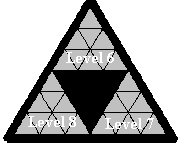![[Main]](pics/main.gif)
Main
Page

Rules, Strategies
and Variants

Software
Downloads

The Klin Zha
Community

About TAKZH
and the Webmaster
These variant rules are by David Barron originally published in "Agonizer" #12 published in December 1999Upward Movement.
    |
Going up a Tier counts as one space moved.Downward Movement
BLOCKADERS, VANGUARDS and LANCERS may rise up one Tier at a time in one turn.
FENCERS and SWIFTS may rise up two Tiers at a time in one turn.
FLYERS may rise up any number of tiers in one turn.
Pieves are not required to move off of Tier 1 if it is not desired.
BLOCKADERS and VANGUARDS may descend only one Tier at a time.Sideward Movement
SWIFTS and FLYERS may descend any number of Tiers in a turn.
Pieces cannot "jump" acros spaces (chasms) from one Level to another. Movement must be first up or down, then across, then back up or down.Directional Restrictions
The rules stating that a piece may move ". . in any direction . ." or ". . in a straight line . ." are to be though of in three directions. For instance, if a piece that has a capability of two spaces per move wishes to move upwards, which will use up one of the two spaces it is allotted, then which direction may it move if it is only allowed to move in a straight line? The answer, of course, is "any direction!" Since the first referent is "up" there can be no restriction of direction for the next space moved.The Blockader
Should the same question be applied to a piece that has the capability of three spaces to move, one would only have to think of the same three dimensions. If the first move is upwards and the next move is to the right, the third move would follow traditional rules of movement for that piece.
The only exception is if that piece used its remaining move to go back downward. This sort of up then down, or down then up movement is allowable with only two restrictions:
First, no piece may return to the space it began its turn from in that same turn.
Second, no piece may change its vertical movement more than twice in one turn. So, while the piece may go UP, the ACROSS, then DOWN, it may not go UP again in the same turn.
For the capabilities of the blockader we must again think in three dimensions. If the Blockader is on Tier Two, he blocks not only the spaces surrounding him on that level but the spaces directly above and below him as well.Capture and Kill
All rules applying to the capture and/or killing of opponent pieces in the traditional flat-board klin zha apply in Tri-Level klin zha as well. A piece landing on a space occupied by an opponent piece is said to have captured or killed the opponent piece.Occupied Spaces
This cannot be accomplished in either upward or downward movement. If a gold piece is in a space directly above a green piece, neither the green or the gold piece may move vertically to capture or kill the other. Capture or kill of opponents may only be accomplished hin a horizontal manner, face to face.
All rules for the passing of pieces through occupied spaces apply here as they would in the flat-board game. If a piece is allowed to move through or over an occupied space in the flat-board game, it is allowed to do so here. If there is no allowance to do so in the flat-board game, then it is not allowed.The Goal
Here again we must think in a three dimensional sense. If a gold piece wants to move three spaces, the first space being UP, and the gold piece is NOT allowed to move through or over occupied spaces, then that gold player must have a clear space above it to move UP. The same move MAY be accomplished by moving sideways first, then moving upwards.
Getting the Goal to the unclaimed corner does not constitute a win.